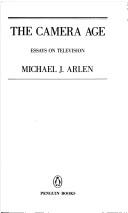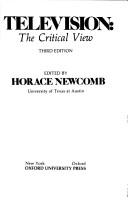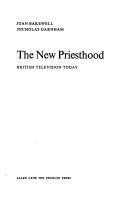| Listing 1 - 10 of 1312 | << page >> |
Sort by
|
Book
ISBN: 0738164976 Year: 2010 Publisher: New York, N.Y. : IEEE,
Abstract | Keywords | Export | Availability | Bookmark
 Loading...
Loading...Choose an application
- Reference Manager
- EndNote
- RefWorks (Direct export to RefWorks)
This standard defines the protocol and data formats for communication devices forming a beaconing network that are used to protect low-power, licensed devices operating in television broadcast bands from harmful interference generated by license-exempt devices, such as Wireless Regional Area Networks (WRAN), intended to operate in the same bands. The devices being protected are devices licensed as secondary under Title 47, Part 74, Subpart H in the USA and equivalent devices in other regulatory domains.

ISBN: 014006107X Year: 1982 Publisher: Harmondsworth Penguin books
Abstract | Keywords | Export | Availability | Bookmark
 Loading...
Loading...Choose an application
- Reference Manager
- EndNote
- RefWorks (Direct export to RefWorks)
Book
ISBN: 8835951917 Year: 2002 Publisher: Roma Ed. Riuniti
Abstract | Keywords | Export | Availability | Bookmark
 Loading...
Loading...Choose an application
- Reference Manager
- EndNote
- RefWorks (Direct export to RefWorks)

ISBN: 0195030796 Year: 1982 Publisher: New York (N.Y.) Oxford university press
Abstract | Keywords | Export | Availability | Bookmark
 Loading...
Loading...Choose an application
- Reference Manager
- EndNote
- RefWorks (Direct export to RefWorks)

ISBN: 0030558069 Year: 1981 Publisher: New York (N.Y.): Praeger
Abstract | Keywords | Export | Availability | Bookmark
 Loading...
Loading...Choose an application
- Reference Manager
- EndNote
- RefWorks (Direct export to RefWorks)
Book
Year: 2013 Publisher: Amsterdam : Amsterdam University Press,
Abstract | Keywords | Export | Availability | Bookmark
 Loading...
Loading...Choose an application
- Reference Manager
- EndNote
- RefWorks (Direct export to RefWorks)
Television is evolving rapidly. How, then, might we respond to television today in light of its past? And do the old theoretical concepts still apply, or must we invent a new framework for this mutable medium? To answer these fundamental questions, the contributors to this provocative collection examine diverse case studies, including up-to-date scholarship on the current television zeitgeist, nostalgic programming on broadcast television, YouTube, and public television art programming of the 1980s. As a whole, these essays challenge the supposed crisis in television in the light of its burgeoning development.
Periodical
Year: 2001 Publisher: London ; New York, NY : Cahners Business Information,
Abstract | Keywords | Export | Availability | Bookmark
 Loading...
Loading...Choose an application
- Reference Manager
- EndNote
- RefWorks (Direct export to RefWorks)

Abstract | Keywords | Export | Availability | Bookmark
 Loading...
Loading...Choose an application
- Reference Manager
- EndNote
- RefWorks (Direct export to RefWorks)
Multi

ISBN: 9782271128027 2271128021 Year: 2020 Publisher: Paris : CNRS Éditions,
Abstract | Keywords | Export | Availability | Bookmark
 Loading...
Loading...Choose an application
- Reference Manager
- EndNote
- RefWorks (Direct export to RefWorks)
Coincée entre la « télévision des maîtres d’école » et la télévision commerciale, la télévision des années 70 a bénéficié de peu d’intérêt de la part des chercheurs. Pourtant cette décennie est le théâtre de nombreuses transformations : la création d’une nouvelle chaîne, fondée sur l’idée de régionalisation, l’introduction de la publicité de marque, l’éclatement de l’ORTF. Si chacun de ces événements a parfois retenu l’intérêt des historiens, on s’est peu préoccupé de leurs incidences sur les programmes et la programmation. Ces nouvelles chaînes qui accèdent à leur autonomie sont traversées par deux forces antagoniques : l’une, qui relève encore de l’enthousiasme d’hommes de télévision cherchant à doter ce média de toutes ses possibilités expressives, à mettre la télévision en jeu par l’invention de toutes sortes de dispositifs d’émissions ; l’autre, qu’incarnent ceux qui ont compris que la logique économique de la concurrence imposait de penser les programmes dans une grille, et qui utiliseront les divertissements pour coller à la temporalité du spectateur. Cette relation au temps est peut-être la mutation la plus profonde qui s’accomplit alors devant les téléspectateurs des seventies : de la valorisation intemporelle du patrimoine, qui guidait la télévision des années 60, on passe à l’ère de l’information culturelle, bientôt à celle de la promotion. De plus en plus ancrée dans l’actualité, la télévision abandonne peu à peu tout ce qui pouvait encore appartenir à l’aléa de l’expérimentation pour se conformer à des formats internationaux dictés par les industries culturelles.
Book
ISBN: 9780230367166 Year: 2013 Publisher: Basingstoke Palgrave Macmillan
Abstract | Keywords | Export | Availability | Bookmark
 Loading...
Loading...Choose an application
- Reference Manager
- EndNote
- RefWorks (Direct export to RefWorks)
"National TV and government broadcasting policies in the Arab countries have been experiencing dramatic changes for more than a decade, but challenges remain. At a time when high hopes are raised by the revolutions in Arab countries, the present book is crucial. The real, sometimes overwhelming changes observed in the national broadcasting in many Arab countries are more likely the result of the progressive evolution of broadcasting than a sudden and brutal mutation. Senior scholars and authors of distinguished writings on medias in Arab countries provide here a state-of-the-art analysis of the situation of national television, and address the following central question: What do the Arab national broadcastings say today about public policy in this sector and about political opening? The contributors to this volume deal with the reforms of public broadcasting organizations, relationships between national, private and public actors in this sector, and finally the evolution, perspectives and issues of national broadcasting"--
| Listing 1 - 10 of 1312 | << page >> |
Sort by
|

 Search
Search Feedback
Feedback About UniCat
About UniCat  Help
Help News
News